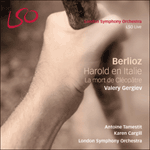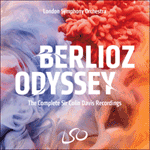
Welcome to Hyperion Records, a British classical label devoted to presenting high-quality recordings of music of all styles and from all periods from the twelfth century to the twenty-first.
Hyperion offers both CDs, and downloads in a number of formats. The site is also available in several languages.
Please use the dropdown buttons to set your preferred options, or use the checkbox to accept the defaults.

 PERFORMANCE
PERFORMANCE RECORDING
RECORDINGThe first movement (‘Harold in the mountains. Scenes of melancholy, happiness and joy’) opens with a darkly chromatic fugato passage, beginning on cellos and basses, with a plaintive bassoon and oboe counter-subject. Woodwind add a melancholy tune which will be revealed as a minor-key version of the ‘Harold’ theme. The music rises to a grand, cloudy fortissimo, after which the fugato resumes, culminating in a flourish, whereupon the texture clears, G minor becomes G major with the effect of sudden sunshine breaking through, and harp arpeggios introduce the soloist and the main theme, a long, open-hearted melody with a touch of melancholy. The theme, restated in slightly shorter form and in canon, richly scored, leads to an allegro, in 6/8 time and with an easy, swinging gait (speed is reserved for the coda). The sprightly second theme only feints at the orthodox dominant key; and, once the exposition of the musical material has run its course, the formal elements (development, recapitulation, coda) merge in a continuous process, in which the cross-rhythms and superimposed metres that are a feature of the work are prominently displayed.
The second movement (‘March of pilgrims singing the evening prayer’) moves in a single arc (pppp to f, then back to pppp) which contains three musically developed ideas: the procession’s approach across the evening landscape and its disappearance into the dusk, the gradual change from day to night, and the curve of feeling in the solitary observer of the scene, from contentment to angst and isolation. The musical materials are a broad E major theme, variously harmonized, above a trudging bass; two bell-like sonorities which recur constantly (a tolling C natural on horns and harp and a thinner, brighter sounding B on flute, oboe and harp), a fragment of chorale, and the comments of the solo viola, first with the ‘Harold’ theme, then as a series of arpeggios played on the bridge of the instrument. In the long final diminuendo the bell note and the march theme (pizzicato strings) grow fainter and fainter until only the viola is left.
The idea for the third movement (‘Abruzzian mountain-dweller’s serenade to his mistress’) came from the music of the pifferari, strolling wind players whom Berlioz encountered during his stay. A rapid, skirling tune on oboe and piccolo above a drone bass, accompanied by a persistent rhythm on the orchestral violas, gives way to an allegretto half the speed, whose cor anglais melody is embellished by other woodwind and then combined with the (thematically related) ‘Harold’ theme. The allegro is then briefly repeated, after which the music and tempos of the two sections are combined, while, high above, the ‘Harold’ theme rings out on flute and harp.
The finale (‘Brigands’ orgy. Reminiscences of the preceding scenes’) begins with a brusque call to order, full of vigorous syncopations. Then the themes of the previous movements are reviewed in turn and rejected, after the manner of the finale of Beethoven’s ninth symphony (though for opposite reasons: Beethoven’s is to introduce a new element, the voice; Berlioz’s to get rid of the soloist). Harold’s theme is the last to go, becoming gradually more indistinct before the gathering onslaught of the brigands’ music. Rhythm, with the percussion unleashed, is now dominant, and brilliant orchestral colour. Towards the end the orchestral momentum breaks off, and we hear in the distance (two violins and one cello, offstage) an echo of the pilgrims’ march. The solo viola is stirred to momentary response. Then its nostalgic comments merge in the tumult of the orchestra, and the orgy resumes and carries the movement con fuoco to its headlong conclusion.
from notes by David Cairns © 2018
Le premier mouvement («Harold aux montagnes. Scènes de mélancolie, de bonheur et de joie») débute avec un passage fugato au sombre chromatisme, qui commence aux violoncelles et contrebasses, avec un contre-sujet plaintif au basson et hautbois. Les bois ajoutent un air mélancolique qui se révélera comme une version en mineur du thème de «Harold». La musique monte jusqu’à un grand fortissimo nébuleux, le thème fugato reprend, culminant de façon théâtrale, puis la texture s’éclaircit, sol mineur devient sol majeur ce qui produit l’effet d’une percée soudaine du soleil; des arpèges de harpe introduisent le soliste et le thème principal, une mélodie longue et franche avec une touche de mélancolie. Le thème, réexposé sous une forme légèrement plus courte et en canon, richement instrumenté, mène à un allegro à 6/8 et avec une démarche modérée et oscillante (la vitesse est réservée à la coda). Le deuxième thème alerte esquive seulement la tonalité orthodoxe de la dominante; et, une fois terminée l’exposition du matériel musical, les éléments formels (développement, réexposition, coda) fusionnent dans un processus continu, où les superpositions rythmiques et les mètres superposés, caractéristiques de cette œuvre, occupent une place importante.
Le deuxième mouvement («Marche de pèlerins chantant la prière du soir») évolue selon un seul arc (de pppp à f, puis retour à pppp) qui contient trois idées développées sur le plan musical: l’approche de la procession dans le paysage nocturne et sa disparition dans la semi-obscurité, le passage progressif du jour à la nuit, et la courbe de sentiment chez l’observateur solitaire de la scène, de la satisfaction à l’angoisse existentielle et à l’isolement. Les matériels musicaux sont un large thème en mi majeur, diversement harmonisé, sur une basse qui marche d’un pas lourd, deux sonorités proches de celles des cloches qui reviennent constamment (un do naturel sonnant aux cors et à la harpe et un si plus fin et plus brillant à la flûte, au hautbois et à la harpe), un fragment de choral, et les commentaires de l’alto solo, tout d’abord avec le thème de «Harold», puis comme une série d’arpèges joués sur le chevalet de l’instrument. Dans le long diminuendo final, la note de cloche et le thème de marche (cordes pizzicato) s’affaiblissent de plus en plus jusqu’à ce qu’il ne reste que l’alto.
L’idée du troisième mouvement («Sérénade d’un montagnard des Abruzzes à sa maîtresse») vient de la musique des pifferari, instrumentistes à vent ambulants que Berlioz rencontra au cours de son séjour. Une mélodie rapide au son aigu de cornemuse, au hautbois et au piccolo sur une basse en bourdon, accompagnée par un rythme persistent aux altos de l’orchestre, fait place à un allegretto deux fois moins rapide, dont la mélodie de cor anglais est ornée par d’autres instruments de la famille des bois, puis associée au thème de «Harold» (apparenté sur le plan thématique). L’allegro fait ensuite l’objet d’une brève reprise, avant que la musique et les tempos des deux sections se combinent, tandis que, dans l’aigu, le thème de «Harold» retentit à la flûte et à la harpe.
Le finale («Orgie de brigands. Souvenirs des scènes précédentes») commence par un brusque rappel à l’ordre, plein de vigoureuses syncopes. Les thèmes des mouvements précédents sont ensuite tour à tour passés en revue et rejetés, à la manière du finale de la neuvième symphonie de Beethoven (mais pour des raisons opposées: Beethoven cherche à introduire un élément nouveau, la voix; Berlioz à se débarrasser du soliste). Le thème de «Harold» est le dernier à disparaître, devenant peu à peu plus difficile à distinguer avant l’attaque croissante de la musique des brigands. Le rythme, avec des percussions déchaînées, est maintenant dominant, la couleur orchestrale brillante. Vers la fin, l’élan orchestral s’arrête net et l’on entend au loin (deux violons et un violoncelle, en coulisse) un écho de la marche des pèlerins. L’alto solo se voit confier une réponse momentanée. Ses commentaires nostalgiques se fondent ensuite dans le tumulte de l’orchestre, et l’orgie reprend, portant le mouvement con fuoco à sa conclusion vertigineuse.
extrait des notes rédigées par David Cairns © 2018
Français: Marie-Stella Pâris
Der erste Satz („Harold in den Bergen. Szenen von Melancholie, Glück und Freude“) beginnt mit einem chromatisch-düsteren Fugato der Celli und Kontrabässe und einem klagenden Kontrasubjekt von Fagott und Oboe. In den Holzbläsern erklingt eine melancholische Melodie, die sich als Mollfassung des Harold-Themas entpuppt. Die Musik erreicht einen mächtigen, noch immer umwölkten Höhepunkt, und das Fugato kehrt wieder; es mündet in eine große Schlusskadenz, und nun hellt die Musik auf: aus g-Moll wird G-Dur, als bräche plötzlich die Sonne durchs Gewölk; und unter Harfen-Arpeggien werden der Solist und das Hauptthema vorgestellt, eine noble, weitgeschwungene und melancholisch angehauchte Melodie. Das Thema, nun leicht gekürzt, groß orchestriert und in Kanonform, leitet über in ein Allegro in locker schwingendem 6/8-Takt (wirklich rasch wird erst die Coda sein). Das lebhafte zweite Thema deutet die übliche dominantische Nebentonart lediglich an; und nachdem das Material einmal eingeführt ist, verschmelzen die Formteile (Durchführung, Reprise und Coda) zu einem einzigen, gleitenden Prozess, in dem jene Kreuzrhythmen und übergreifende Metren zur Geltung kommen, die das Werk prägen.
Der zweite Satz („Marsch der Pilger beim Singen des Abendgebets“) bildet einen einzigen, großen formalen Bogen (vom pppp zum f und wieder zurück zum pppp), in dem drei Gedanken musikalisch entwickelt werden: das Erscheinen der Prozession in der abendlichen Landschaft und ihr Verschwinden in der Dämmerung, der Verlauf vom Abend zur Nacht und das Empfinden des einsamen Beobachters der Szene, das sich von Behaglichkeit zu Beklemmung und Isolation wandelt. Das Material bilden ein breites E-Dur-Thema über einem schreitenden Bass, zwei glockenartige, beharrlich wiederkehrende Klänge (ein C von Hörnern und Harfe und das schmaler klingende H von Flöte, Oboe und Harfe), das Bruchstück eines Chorals und die Kommentare der Solobratsche, zuerst mit dem Harold-Thema, dann mit einer Kette von nah am Steg gespielten Arpeggien. Im langen Schluss-Diminuendo werden der Glockenton und das von den Streichern pizzicato gespielte Marschthema immer schwächer, bis allein die Bratsche übrigbleibt.
Der dritte Satz („Serenade eines Abruzzen-Bewohners an seine Geliebte“) ist inspiriert von der Musik der Pifferari, der wandernden Bläser, denen Berlioz in Italien begegnet war. Ein rasches Dudelsackthema von Oboe und Piccolo über einem Bass-Bordun, begleitet von einem stetigen Rhythmus der Bratschen, weicht einem Allegretto im halben Tempo, dessen Englischhornmelodie von den anderen Holzbläsern verziert und später mit dem (thematisch verwandten) Harold-Thema kombiniert wird. Das Allegro wird kurz wiederaufgenommen; dann werden Tempi und Themen der beiden Abschnitte kombiniert, während hoch in Flöte und Harfe das Harold-Thema erklingt.
Das Finale („Orgie der Briganten. Erinnerungen an die vorangegangenen Szenen“) beginnt mit einem jähen Weckruf voller heftiger Synkopen. Dann werden die Themen der vorigen Sätze aufgegriffen und verworfen, ähnlich wie in Beethovens 9. Sinfonie (allerdings aus einem anderen Grund: Beethoven will ein neues Element einführen, die Singstimme; Berlioz will den Solisten zum Schweigen bringen). Als letztes muss das Harold-Thema gehen; er verliert unter dem Ansturm der Brigantenmusik immer mehr an Kontur. Nun herrscht der Rhythmus des entfesselten Schlagzeugs und die Brillanz der Orchesterfarben. Gegen Ende verliert sich der Schwung des Orchesters, und in der Ferne vernehmen wir ein Echo des Pilgermarsches; es ruft die scheinbar spontane Reaktion der Solobratsche hervor. Doch ihre nostalgischen Kommentare gehen bald im Orchestertumult unter, die Orgie geht weiter und bringt den Satz con fuoco zu seinem stürmischen Abschluss.
aus dem Begleittext von David Cairns © 2018
Deutsch: Friedrich Sprondel
 Berlioz: Harold en Italie & Cléopâtre Berlioz: Harold en Italie & CléopâtreViolist Antoine Tamestit and mezzo-soprano Karen Cargill join forces with the London Symphony Orchestra and Valery Gergiev in the latest instalment of their Berlioz exploration: 'Harold en Italie' and the cantata 'Cléopâtre'.» More |
 Berlioz: Odyssey Berlioz: OdysseySir Colin Davis was internationally recognized as the foremost Berlioz interpreter of his time, and the recordings he made with the London Symphony Orchestra stand as some of the greatest accounts of the composer’s work ever recorded.» More |

